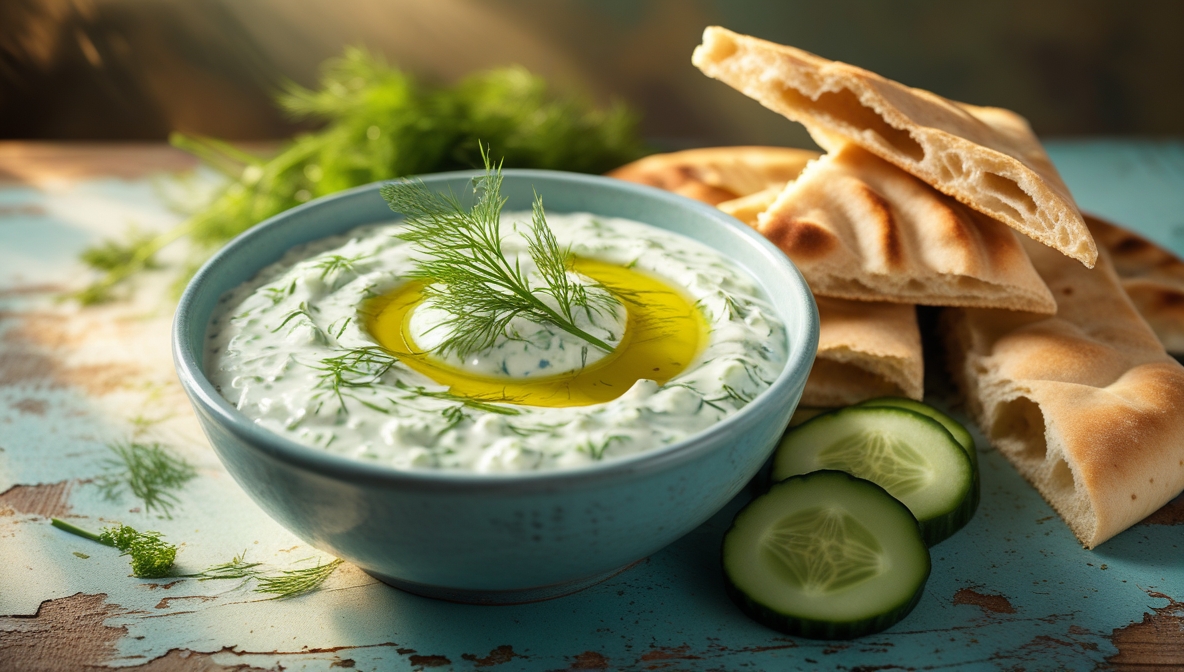Introduction
Among the most beloved Famous Foods in Greece, one dish stands out for its creamy texture and refreshing flavors — Tzatziki. This iconic dip, sauce, and side dish perfectly captures the essence of Traditional Greece Food. Made with yogurt, cucumber, garlic, and herbs, it’s a culinary classic that enhances grilled meats, pita bread, and vegetables alike. More than just a condiment, it’s a flavorful representation of Greek hospitality and heritage.


History & Cultural Significance
The origins of Tzatziki can be traced back to ancient times, with influences from the Ottoman Empire and Middle Eastern cuisine. Over time, it evolved into a staple of the Mediterranean diet in Greece, celebrated for its use of fresh, local ingredients. As a key part of Traditional Greece Food, it’s commonly served at communal gatherings and festivals, often as a cooling companion to spicy or savory dishes.
Served as part of a meze platter, it reflects Greece’s love of sharing meals. Its presence at both casual family dinners and festive occasions marks its cultural importance in Greek culinary traditions.
Ingredients & Regional Variations
The Best Tzatziki Recipe is simple, relying on a few core ingredients:
Greek yogurt: Full-fat and thick for creaminess.
Cucumber: Grated or finely diced, adds crunch and freshness.
Garlic: Brings a bold, sharp flavor.
Olive oil: Enhances richness and smoothness.
Herbs: Typically dill or mint, but regional twists may add parsley or thyme.
Lemon juice or vinegar: Offers a bright, acidic contrast.
Variations exist across the country. On the island of Crete, extra garlic or more olive oil might be used. In the Cyclades, you might find hints of lemon zest. Some modern adaptations add feta or sun-dried tomatoes for a twist on the traditional.
Cooking Process & Difficulty Level

Creating the Best Tzatziki Recipe at home is simple:
Grate the cucumber and press to remove excess water.
Combine thick Greek yogurt, garlic, herbs, olive oil, and lemon juice.
Season with salt and mix thoroughly.
Chill for 30 minutes before serving.
Difficulty Level: Beginner-friendly — no cooking involved, just simple mixing!
Where to Eat Tzatziki in Greece
Wondering Where to Eat Tzatziki in Greece? It’s available in almost every Greek taverna, but a few spots are especially well-known:
Kiki’s Tavern, Mykonos: Offers a fresh, daily-made version alongside grilled meats.
Ta Karamanlidika Tou Fani, Athens: A delicatessen famous for pairing creamy dips with charcuterie.
O Kostas, Athens: This legendary souvlaki spot serves a delicious homemade variety.
Spondi, Athens: For a fine-dining take, this Michelin-starred restaurant elevates the dish with gourmet ingredients.
These establishments showcase Tzatziki in both rustic and refined ways, making them must-visit destinations for food lovers.
Pairing with Drinks & Side Dishes
This cooling dip complements a range of dishes and beverages:
Drinks: Pair it with a crisp Assyrtiko wine, Ouzo, or mint tea.
Side Dishes: Enjoy it with warm pita, grilled lamb or chicken, falafel, roasted potatoes, or raw veggies like carrots and bell peppers.
Its versatility also makes it a fantastic dip for olives or pita chips — perfect for a Mediterranean-inspired snack platter.
Fun Facts & Lesser-Known Trivia
Celebrity Favorite: Popular travel hosts like Anthony Bourdain have praised it in their shows, contributing to its global fame.
Healthy Choice: Made from Greek yogurt and fresh produce, it’s low in calories but high in nutrition.
Cultural Icon: As one of the most Famous Foods in Greece, it plays a key role in the country’s meze dining culture.
Health Benefits & Nutrition
Tzatziki is both tasty and nourishing:
Protein-rich: Thanks to Greek yogurt, it’s a great source of protein.
Vitamin-packed: Cucumbers and garlic provide vitamin C, potassium, and antioxidants.
Heart-healthy: Olive oil adds beneficial fats.
Low in Calories: It’s ideal for those seeking a lighter yet flavorful dish.
Vegan and gluten-free versions are widely available, making it an inclusive option for different dietary needs.
How to Make the Best Tzatziki Recipe at Home
Ingredients:
1 cup Greek yogurt
1 cucumber, grated and drained
2 garlic cloves, minced
2 tbsp olive oil
1 tbsp lemon juice
1 tsp chopped dill or mint
Salt and pepper to taste
Instructions:
Grate the cucumber and remove water.
Mix with yogurt, garlic, herbs, olive oil, lemon juice, salt, and pepper.
Chill for at least 30 minutes.
Serve cold with your favorite Mediterranean dishes.
Pro Tips:
Opt for full-fat yogurt for richness.
Adjust garlic levels to suit your preference.
Add lemon zest for extra brightness.
Global Influence & Fusion Cuisine
As one of the Famous Foods in Greece, Tzatziki has inspired variations across the globe. In the U.S., it’s found in wraps, salads, and grain bowls. Chefs have created fusion versions by adding chili, cumin, or even avocado. Its lightness and flavor make it ideal for health-conscious and gourmet menus alike.
Comparison with Similar Dishes
Tzatziki vs. Raita (India): Both are yogurt-based dips with cucumber, but Raita often contains a wider variety of spices and herbs like cumin and coriander.
Tzatziki vs. Sour Cream: While sour cream can be similar in texture, Tzatziki is much lighter, thanks to the yogurt, and has a more complex flavor due to the cucumber and garlic.
Tzatziki vs. Baba Ghanoush (Middle East): Baba Ghanoush is made from roasted eggplant, and while it shares a similar creamy consistency with Tzatziki, it has a smokier, earthier flavor.

